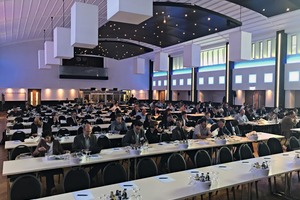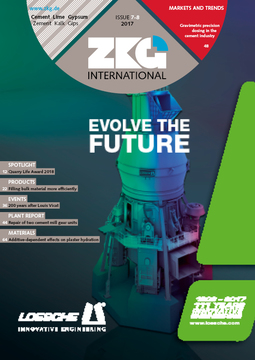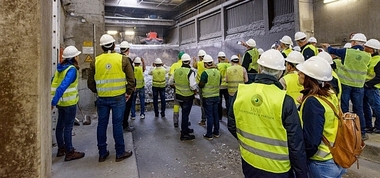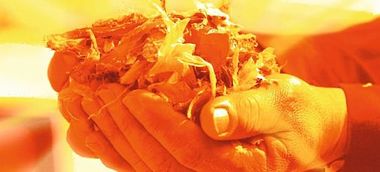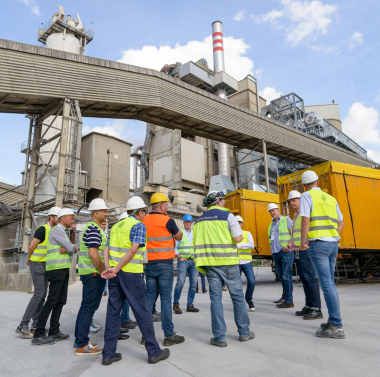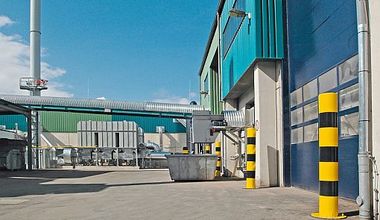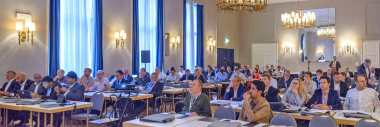Efficient recovery solutions
for alternative resources
Participants from 41 countries joined the 7th International Symposium 2017 on MBT, MRF & Recycling in Hanover from 16.05.–18.05.2017 in order to discuss latest trends in recycling and waste treatment technologies, the evolution of the European circle economy, biomass treatment as well as alternative fuels production throughout the world.
Wasteconsult International and the ASA e.V. (committee for substance-specific waste management) organize this symposium every two years with the aim of bringing together experts from developed, developing and emerging countries to share their experience and developments in waste management worldwide. This year’s program was specialized on resources and energy from waste. In this context, presentations were held regarding effects of different framework conditions and quality assurance procedures on the production of alternative fuels, biomass, and co-incineration in coal-fired power plants as well as cement plants. The official patronage for this event is Barbara Hendricks, the German Minister of Environment.
Sabine Flamme and Sigrid Hams (BGS e.V. and Fachhochschule Münster) gave an introduction speech about the status quo of solid recovered fuels (SRF) in Germany. In recent years the quantity of SRFs (3 million Mg/a) in the lime, coal and cement industry is consistently high with an overall upward trend. From that, the coal industry consumes around 30 % and the lime industry a share of maximum 1 %. This underlines that the principal customer for SRFs with a share of around 70–73 % SRFs is the cement industry, which also means that quality is a fundamental concern for both sides, the producer and the customer of SRFs. For this, the Gütegemeinschaft Sekundärbrennstoffe und Recyclingholz e.V. (BGS e.V.) together with RAL-GZ 724 established a quality assurance for products called SBS. The analytical procedures include regular sampling and analytical monitoring of the production of alternative fuels. In addition, they defined guide values for the content of heavy metals and copper, thus other important values such as calorific value, water content, ashes and chlorine. Moreover, Flamme and Hams emphasized that co-incineration of SRFs in the coal and cement industry has positive impacts and great potentials for the reduction of Greenhouse Gas Emissions (GHG), hence for the mitigation of Climate Change. They pointed out that these processes can significantly contribute to a saving of approximately 350–1000 kg CO2eq/Mg.
Preparing capacities for the expected volumes of SRFs
In his paper on co-incineration in coal-fired power plants, Sven Kappa from Lausitz Energie Kraftwerke AG (LEAG) outlined that due to the changes in the European Energy Ordinances and German laws, it is estimated that activities such as co-combustion will increase dramatically in the next years. Because of that, not only the cement industry but also the coal power plant industry is already preparing capacities for the expected volumes of SRFs and on the other site reducing the capacities for coal consumption. Besides that, the German power generation industry is considered a significant factor for the contribution in order to meet the national climate goals.
The share of suitable alternative fuels in the clinker burning process increased continuously in the past years and reached 65 % in 2015, Martin Oerter (Forschungsinstitut der Zementindustrie GmbH) stated in his speech on co-incineration in cement plants. Some substitution rates are even higher, exceeding 80 % in individual cases. The majority of alternative fuels is produced out of industrial and commercial waste, next to animal meal, tires, waste oil, municipal waste and sewage sludge. Key figures of the German cement industry in 2015 demonstrate that for a production of approx. 31 million t of cement and 23 million t of clinker, a share of 58.2 million GJ/a of the total thermal energy demand of 90.1 million GJ/a is produced by alternative fuels. This means an amount of more than 2 million t of hard coal is being substituted by alternative fuels. The use of suitable municipal solid wastes is also possible as long as the material complies with the required quality criteria.
In addition, Oerter pointed out that the growing amounts of processed fractions derived from municipal waste is a direct consequence of the landfill ban from 2005. Regarding dust emissions, he outlined that co-incineration of waste does not affect the clinker burning process and has only a minor influence on the emission of heavy metals. Tests on mortar and concrete cubes resulted in low heavy metal concentrations in the eluates, even noticeably below the German Drinking Water Ordinance, for instance. He accented that solid alternative fuels can contain a large proportion of biogenic carbon, thus latest analysis have shown that the biomass proportion in tires, pre-treated industrial and municipal waste can contribute up to 20 % and 50 % of the carbon contained in the fuel. In conclusion, he took the opportunity to explain that cement companies use selected alternative fuels only, because the materials and the final product must suit the process and the technical and environmental requirements. As a result, this careful selection of secondary input materials ensures that co-incineration of waste does not result in any harmful emissions to the environment and therefore is considered as a Best Available Technique (BAT) for the cement industry in Europe. In fact, until 2050 the EU28 countries want to reach an energy substitution of 60 % by alternative fuels.
Isabelle Zdanevitch (INERIS) discussed the determination of the renewable (biogenic) content of SRF by standardized and non-standardized methods in European countries. First, she presented the principles, advantages, and disadvantages from standardized methods covered by the EN 15440:2011, such as manual sorting, selective dissolution and 14 C measurement in the SRF. The non-standardized methods, on the contrary, are not standardized by CEN on European level, although they are not weaker or less useful. These include mass and energy balance developed and published by Fellner in Vienna University, for example, for which measurements are taken regularly at SRF combustion plants and the renewable part is calculated from the produced electricity by using a set of equations. The final product consists of a mass-energy balance model. Through the “Fixed values” method, the energy provided by the biomass content of a global waste flux is calculated. This method is being applied on a national level, e.g. the Netherlands gain information on the energy from incineration of non-hazardous waste by this method. Currently, there are further methods under development that are not applied yet and can be accessed in the Ademe study as well as the IEA Bioenergy/RSE report from 2012.
Practical studies and experiences
A large number of practical studies and experiences from Europe, South America, Asia and Africa were presented at this event and some concerning alternative fuels will be presented hereinafter. On his paper on Mechanical-biological waste treatment plant for Bangalore west zone, Matthias Kuehle-Weidemeier from Wasteconsult International presented his work in India for the introduction of a suitable treatment plant for 91 000 t/a MSW. He stated that the waste composition resulted in 62.6 % organics, 8.8 % paper/cardboard and 9.9 % plastics with a grain size distribution of 50–50 % for smaller and bigger than 55 mm. Concerning the incineration of waste, his study revealed an average gross calorific value of 8.1 MJ/kg. Although, the fractions bigger than 55 mm reached average values of 11.02 MJ/kg and the smaller fractions only 4.21 to 5.83 %, a lower calorific value of 7.0 to 7.5 MJ/kg for the Door-to-Door collection, litter spots and street sweeping (ratio 50:30:20) was determined. Due to the high content of organics and therefore a high humidity in the mixed waste material, the energy production of an incineration plant would not meet the minimum energy efficiency of 65 %, required by the EU Waste Framework Directive. Hence, a mechanical-biological treatment plant would not only improve the treatment of organic fractions via composting or bio-drying but also the separation of the high calorific fraction for the use as refuse derived fuel (RDF) and valuable materials for recycling.
Another example of development concerning RDF production and cooperation of waste and cement sectors was given by Christiane Dias Pereira (TU Braunschweig Germany and Terra Melhor Ltda. Brazil) in her speech about Brazilian waste management and its symbiosis to the cement market. As the cement industry declared a voluntary obligation to reduce Greenhouse Gas Emissions (GHG) and the Brazilian waste sector has to meet legal requirements for waste treatment in Brazil, a perfect cooperation between these sectors seems not only logical but also necessary. According to the Brazilian Cement Technology Roadmap for current and future technologies, the targets for energy substitution by alternative fuels was set to 17.3 %, this means a potential of 3999 Mt/a (lower calorific value) and 2580 Mt/a (gross calorific value) until 2050. In 2017, the Brazilian cement sector paid about 450 R$/t, or 13.44 GJ/R$, for coal coke and the prices for pre-processed RDF (class 2) reached 201.60 R$/t. In general, this roadmap represents a guide for the cement industry towards a low carbon economy by using technical solutions and knowledge of academic, governmental and financial sectors.
Further Pereira stated that some of the greatest challenges in Brazil are e.g. the market immaturity for the use of MSW as an alternative energy source, knowledge and experiences as well as insufficient waste characterization, which result in investment losses. On the other hand, there are quite a lot of chances due to changes and evolutions on the markets. In Brazil, there is a great potential for co-incineration in cements plants that currently is impeded by a lack of knowledge and investments. The promotion of research in the field of energy substitution is considered a strategic step during the development of public policies as well as the management and planning of processes in companies, not only in regard to waste management but also cement production activities and other potential industries that can use MSW as an alternative energy source. The enhancement of solid waste management, including all steps which can improve the quality and economic value of waste destined for energetic recovery, allows to establish an important market for this fuel.
Conclusion
The participation of experts from all over the world at this year’s event was very important and endorsed the fact that discussions around alternative fuels are not limited by boundaries and follow the purpose of strengthening the technological and economic development on a global level. This way, a responsible market position concerning climate protection and resource preservation is guaranteed. Today, the use of municipal solid waste as alternative fuel is not a question of whether, but when.
//www.waste-to-resources.eu/id-2017.html" target="_blank" >www.waste-to-resources.eu/id-2017.html:www.waste-to-resources.eu/id-2017.html

